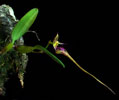|
|
|
|
|
| |
Flasks of
Bulbophyllum appendiculatum '#2' × '#1' |
|
| |
|
|
| |
| Number: |
TN3428 |
| Name: |
Bulbophyllum appendiculatum '#2' × '#1'
(Acquired incorrectly named as Bulbophyllum putidum)
|
| Type: |
outcross (What's that?) |
|
Seed Donor: |
Dale Borders
|
|
Click to Enlarge

Pod Parent Flower |
Click to Enlarge

Pollen Parent Flower |
Click to Enlarge

Pollen Parent Closeup of Flower |
Click to Enlarge

Pollen Parent Blooming Plant |
Click to Enlarge

Pollen Parent Closeup of Flower |
Click to Enlarge

Offspring 'MC5955' Flower |
Click to Enlarge

Offspring 'MC5955' Capsule |
Click to Enlarge

Offspring 'MC5955' Blooming Plant |
| Offspring photos are siblings of the plants you would receive. |
|
|
|
| |
Culture Notes from Donor: Parent plants: Temperature range I (60-83°F)
For additional origin/habitat information supplied courtesy of
Charles and Margaret Baker, see further below, near the bottom of this page.
|
Temperatures we attempt to use in the lab & greenhouse:
| For Species: |
|
Spring, Summer, Autumn, Winter: days average 88°F, nights 71°F; best fit is Warm 90-70°F
(Source:
Baker's Web OSC) |
|
About the name...
| Etymology of |
appendiculatum |
|
From Latin "appendiculatus" with appendages.
(Source:
Mayr & Schmucker 1998) |
| Etymology of |
Bulbophyllum |
|
From Greek "bolbos" bulb; "phyllon" leaf.
(Source:
Pridgeon 1992) |
| Pronunciation of |
appendiculatum |
|
a-pen-dik-yoo-LAH-tum
(Source:
Hawkes 1978) |
| Pronunciation of |
Bulbophyllum |
|
bul-bo-FILL-um
(Source:
Pridgeon 1992) |
|
If you would like to direct someone to this web page, please copy and paste this URL into your email:
http://troymeyers.com/d?013428
| Flask Information |
| Availability: |
We have sold all of the flasks for this item. |
| You should: |
Consider getting individual plants or compots instead of a flask.
You can place a "Notify Flask Recipients" Request, and either we or a flask recipient may contact you when plants are available.
You may also place a "Notify Retries" Request, and if an identical pollination (the same parents) is done again, we'll let you know.
You may reserve a flask, but it's very unlikely you'll get one ...this could only happen if we found a flask that we didn't know we had. |
| Yield Estimate: |
510 plants (based on flask surveys done 01/21/2004 through 10/20/2006)
|
| Plantlet Sizes: |
From many flasks 15 - 45 mm plants (based on flask surveys done 04/12/2004 through 01/29/2007)
From one most recently surveyed flask 20 - 35 mm (01/29/2007)
|
|
You might also want to:
|
View the seed assay for this item.
View items of the same species.
View items of the same genus.
|
| Ordering Information |
| You are not currently logged in. |
|
You must be a registered user and be logged in to reserve a flask or place a notification request. Please log in:
|
|
|
|
|
|
| |
The origin/habitat information below is supplied courtesy of Charles and Margaret Baker
The following information is based on the name of the plant provided by the donor, and assumes that the name is correct. If the plant has been misidentified, then the following information may not be correct.
This text is copyrighted by the Bakers and may not be reproduced without permission.
ORIGIN/HABITAT: Sikkim, Bengal, Thailand, Laos, Malaya, Sumatra, Borneo,
and the Philippine Islands. The type specimen was collected from Lahat
near Palembang in southern Sumatra at about 150 ft. (50 m). We found
specific habitat information for two habitat locations. One habitat near
Satun, in southern peninsular Thailand, is close to the Malayan border.
The Philippine collection occurred in Zambales Province on Luzon Island,
where plants grow on tree trunks in mossy forests at 1300 ft. (400 m).
Holttum (1964) thought that this plant might be found in the Malayan State
of Kedah across the border from the known habitat in Thailand.
Wood & Cribb (1994) reported that the Borneo habitat is unknown, but the
plant is found in Kalamantan and Sarawak. We found no habitat information
for any of the other reported collection areas.
More about this information and the Bakers...
|
|
|
| |
|
|
|